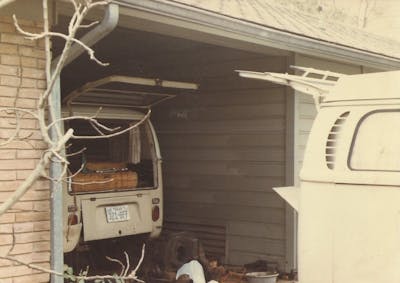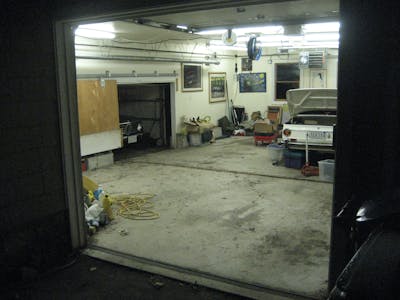Media | Articles
When it comes to my overflowing horde of cars, I have an enabler
We all come to where we are one step at a time. Each of those steps makes sense, even if the resulting destination surprises us. I thought I’d explain how I reached the point where I live in the densely populated city of Newton, Massachusetts, on a 6600-square-foot lot and own 11 cars.
I blame Hagerty, but let’s start at the beginning.
This all began when my wife, Maire Anne, and I moved from Massachusetts to Austin, Texas, in her rusty 1971 Volkswagen Bus in 1982 and I got my first real engineering job. Soon after, I bought my first BMW 2002. Then my second, which overlapped and eventually replaced the first. Then another one to sell and make a little money on. Then a 2000CS coupe to lose it all on. Then a parts car.
The little duplex apartment had a carport and a short driveway. The cars, and their oil leaks, spilled out onto the street.

While this was going on, all those New England winters caught up with Maire Anne’s VW bus. When the bottle jack went through the frame, I found a ’69 Westfalia camper with a blown engine, and I swapped engines.
Marketplace
Buy and sell classics with confidence

When we returned to Boston in 1984 with the resurrected camper and my latest BMW 2002, we moved in with my mother and sister in their house in Brighton. The house had a two-car garage. Inexplicably, my family let me occupy both bays. I can only assume that this was due to the dynamic where youngest siblings are able to get away with murder for most of their lives. After I bought my BMW E9 3.0CSi and had the outer body restored in 1988, it occupied one garage bay full time. The other bay held whatever was my current project at the time. Both my daily driver and Maire Anne’s (not to mention my mother’s and my sister’s), as well as my other project cars, lived on the street, a situation that was pretty rough on those vehicles.

When we started our family and began to outgrow the house’s small third floor in Brighton, we began looking in Newton. While I would’ve preferred a house with oodles of garage space, once you select a town and search within your budget, you find what you find. The house we bought in 1991 had a rusting, leaning, one-car corrugated metal garage. It was awful, but it was enough to hold my fragile, rustprone E9 coupe. Any other cars had to sit outside. I sold my ’84 Alfa Spider rather than leave it to the mercy of the elements.
Of course, the other project cars and the daily drivers sometimes needed work. Unless the weather was good and I could pull the E9 out, any work had to happen in the driveway. I have vivid memories of replacing an exhaust in the Toyota Previa while lying on the asphalt, with rivulets of ice water soaking through my insulated mechanic’s suit and beginning to understand why the rest of sane society was willing to pay someone else to do the work.

At some point in the 1990s, I began buying Suburbans to use as family beach vacation vehicles. This—combined with the daily drivers, the E9, and the project cars—was beginning to produce a sizeable insurance bill. It was at this juncture that I found Hagerty and inquired about insuring the E9. It took a little time to acclimate to the usage restrictions—under the terms of the policy I couldn’t use it as my daily commuter anymore—but the car’s comparatively small insurance bill was the entry to what turned out to be a game-changer. I think that when I first put the E9 on a Hagerty policy and insured it for $25,000, its annual bill was something like $135, the low number helped by my spotless driving record and Newton’s zip code.
A few years later, I scratched a lifelong itch and bought an ’82 Porsche 911SC Targa with a tail. I figured that since this was a late enough car that it had a galvanized body, moisture wouldn’t kill it the way it did my vintage BMWs. There was no garage space for it, so it had to sit outside. I bought a cover for it. Hey, it was that or not have the car, right?

In retrospect, it’s amazing that I wasn’t really thinking yet about renting spaces, but live and learn. And I was about to learn. That’s because that first winter arrived. One day, I pulled the cover off the Porsche to move it and found that the pedals were stuck due to water having seeped through the cover and Targa top and had frozen in a solid block of ice around the pedal’s pivots. When I looked under the front seat, I was horrified to find that the car’s CIS Lambda electronics box was also encased in ice. I felt like an idiot and realized that the car needed to be garaged or else I’d kill it, galvanized body or no. I managed to wrangle “favor” garage space from a neighbor for the rest of the winter, but a longer-term solution was needed.
It was at that point that Maire Anne and I began having serious discussions about building a real garage. The first plan for a stand-alone structure got shot down by the city due to setback issues. The resulting plan for a 31×17-foot attached structure, built in 2005 shortly before my oldest son started college, was a testament to what was possible both within the building codes and our budget. It had a single roll-up door through which two rows of cars could fit. There was enough space for three cars—four if you put one on wheel dollies and skooched it sideways. And, against the left wall, we installed a sliding door that opened up under the deck off the kitchen where a fifth car could be put, carport-style. The 8-foot ceiling height was necessitated by not blocking the dining room window. Unfortunately, this precluded a post lift. As I said, a testament to what was possible.


At some point after the garage was built, I wrote a piece for BMW CCA Roundel magazine titled “Siegel’s Seven-Car Rule,” in which I wrote that a car person with a family needs seven cars. These are:
1) One spouse’s family hauler
2) The other spouse’s daily driver
3) The roadster/convertible for sunny days
4) The four-wheel-drive tow vehicle / snow attack vehicle / beach assault vehicle
5) The track car
6) The pampered classic
7) Whatever the current project car happens to be
“The rule” became quite popular, as it appeared to give a completely rational justification to something that wasn’t rational. Even though this list no longer fit me exactly—I’d given up high-performance driving events years back, and calling the 911SC Targa a “convertible” was a little bit of a stretch—it’s not surprising that, as soon as the garage was finished, I began stuffing it with cars.
The first was a 2002. Amazingly, I, the 2002 guy, hadn’t owned a 2002 in 15 years due to my one-car garage needing to hold the E9. Before the sheetrock was even up on the walls, I bought a just-painted ’73 2002tii that needed reassembly. Of course, I insured it with Hagerty. A 2002tii wasn’t worth what they are now. I think I valued it at $2500, and its annual insurance cost was that of a couple of pizzas.
Shortly after, I bought the 1999 BMW Z3 M Coupe (a.k.a. “The Clown Shoe”). Being a newer car, that had to be put on a regular insurance policy. I think that the first winter I had the garage, I put the E9 3.0CSi, the 911SC, and the M Coupe inside, the tii behind the sliding door, and left the last spot behind the roll-up door open in case the daily drivers needed repairs.

And as the number of cars increased, Hagerty came in as a major enabler. Once the 911SC was 25 years old, it too went on the policy. Then, when Massachusetts auto insurance rules were relaxed and newer cars like the Z3 M Coupe could be insured with guaranteed-value policies, the clown shoe joined the other three Hagerty cars.
With insurance costs no longer a gating factor, the sixth and seventh slots in the seven-car rule—the ones for “pampered classic” and “whatever the current project car happens to be”—yawned open wide. I vividly recall buying the ’73 BMW Bavaria for $4000, loading it on the trailer and calling Hagerty before towing it home.
“Hi, my name is Rob Siegel. I have a policy with you. I’d like to add a car.”
“What’s the year, make, and model of your latest purchase, Mr. Siegel?”
“1973 BMW Bavaria.”
“What would you like to insure it for?”
“Oh, I don’t know … what I paid for it—four grand.”
“Mr. Siegel, your annual cost for the car will be $36. The incremental cost on this year’s policy will be $24.”
Then I said what I now say every time I insure a new $4000 purchase with Hagerty and get quoted what two five-quart bottles of Castol and a filter would cost me: “OK, this is the part where I say, I LOVE YOU GUYS!”
The point here is that I’ve been a raving Hagerty fan for far longer than I’ve been writing for Hagerty. While many people think of Hagerty and other guaranteed-value insurers as the place to go to make sure their Cobra or E-Type is appropriately valued in case their trophy garage is hit by a tornado or flooded by a hurricane, I came to appreciate it from a bottom-feeder’s perspective. What it meant to me was that I could now buy every $4000 beater car I’ve always wanted and only pay peanuts a year in insurance, provided I had somewhere to garage it. This became the single largest enabling factor in the floodgates getting kicked open and my having enough cars that I have to say, “I’m not a collector.”
With the spaces in the garage at my house filled, I began looking at rented space. Garage space in suburban Boston is expensive, but I found that, if you head outside Rt. 495, it drops off sharply. About 50 miles away, I found an old five-bay garage whose spaces the owner was renting for $50 each per month. As I bought more cars, I grabbed more of the spaces, eventually renting four. The rent eventually increased to $75 each, but still, $300/month for four rented spaces is the other enabling factor.

Obviously, as the value of the cars has gone up, and as I’ve increased the coverage to keep pace, the cost of my policy has gone up too, but I’m insuring the six vintage BMWs (the ’73 3.0CSi,’73 Bavaria, 2002tii, two 2002s, and the ’79 Euro 635CSi), the Clown Shoe, and the ’74 Lotus Europa Twin Cam Special for about a grand a year. I love you guys!
With the eight cars currently on my Hagerty policy, the four spaces in the Newton garage, the four rented garages, and our two daily drivers and little Winnebago Rialta RV sitting in the driveway, I’m all set. The overflow space behind the slider that opens under the back deck is currently filled with stuff like an engine hoist, lift table, transmission jack, and spare 2002tii engine, but there’s no real reason to clean it.
Until I see something else that I can’t live without.
After all, it’s been nearly a year since I called Hagerty and said, “I love you guys.”
***
Rob Siegel has been writing the column The Hack Mechanic™ for BMW CCA Roundel magazine for 34 years and is the author of six automotive books. His most recent book, Just Needs a Recharge: The Hack Mechanic™ Guide to Vintage Air Conditioning, is available on Amazon (as are his other books), or you can order personally-inscribed copies here. His new book, The Lotus Chronicles, will be released in late September.











